Natterer's
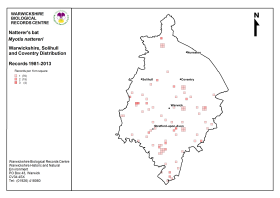
Distribution map for Natterer's bats in Warwickshire. (Click for a full sized image)
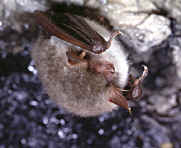 Natterer's bat (Myotis nattereri) is a medium-sized species.
The
ears are narrow, fairly long and slightly curved backwards at the tip;
pink at the base, a little darker at the tip. The inner lobe of the ear
(the tragus) is long, narrow and sharply pointed. A characteristic feature
of this species is a fringe of very stiff bristles along the trailing
edge of its broad tail membrane. Its rather pinkish limbs give rise to
its old name of 'red-armed' bat.
Natterer's bat (Myotis nattereri) is a medium-sized species.
The
ears are narrow, fairly long and slightly curved backwards at the tip;
pink at the base, a little darker at the tip. The inner lobe of the ear
(the tragus) is long, narrow and sharply pointed. A characteristic feature
of this species is a fringe of very stiff bristles along the trailing
edge of its broad tail membrane. Its rather pinkish limbs give rise to
its old name of 'red-armed' bat.
Natterer's bats are found throughout most of the British Isles. Recent
records have extended its range in Scotland, north to the Great Glen fault.
Generally it is a scarce and poorly known species. It is widespread in
Europe, north to southern Scandinavia.
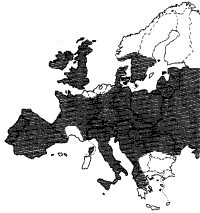 The UK population of Natterer's bats is probably of international importance.
For the conservation of summer roosts the conversion of barns and the
maintenance and remedial treatment of other older buildings needs to be
carefully monitored. With a significant reliance on underground sites
for hibernation, important wintering sites should be protected.
The UK population of Natterer's bats is probably of international importance.
For the conservation of summer roosts the conversion of barns and the
maintenance and remedial treatment of other older buildings needs to be
carefully monitored. With a significant reliance on underground sites
for hibernation, important wintering sites should be protected.
flight & ultrasound
Natterer's bats have a slow to medium flight speed, sometimes over water,
but more often amongst trees where their broad wings and tail membrane
give them great manoeuvrability at slow speed. They normally fly at heights
of less than 5 m but occasionally my reach 15 m among the tree canopy.

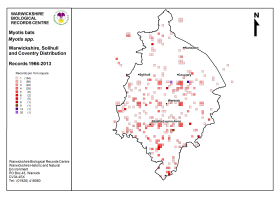
Distribution map for all species of Myotis bats in Warwickshire. (Click for a full sized image)
Much of the prey is taken from foliage and includes many flightless or
day-flying insects. Sometimes larger prey is taken to a feeding perch.
It prefers foraging in semi-natural broad-leaved woodland and tree-lined
river corridors.
The echolocation calls of the Natterer's bat are very quiet. Their frequency
range is 35 - 80 kHz with a peak about 50 kHz. On a heterodyne bat detector
the calls are heard as irregular rapid clicks, with a sound similar to
that of stubble burning.
 Natterer's bat call on a Time Expansion bat detector.
Natterer's bat call on a Time Expansion bat detector.
breeding
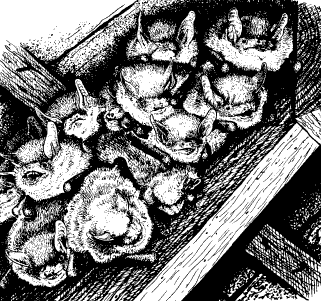 Mating
occurs in the autumn but has been observed in all winter months. Maternity
colonies of adult females are formed from May to June through to July
and sometimes until September - October. They may changed roost site frequently.
The female gives birth to its single young at the end of June or early
July. For the first 3 weeks the young bat feeds only on its mother's milk
and is left in a crèche inside the roost when its mother goes out at night
to feed. During this time the young may make its first flight inside the
roost and within 6 weeks is fully weaned and able to forage for itself.
Mating
occurs in the autumn but has been observed in all winter months. Maternity
colonies of adult females are formed from May to June through to July
and sometimes until September - October. They may changed roost site frequently.
The female gives birth to its single young at the end of June or early
July. For the first 3 weeks the young bat feeds only on its mother's milk
and is left in a crèche inside the roost when its mother goes out at night
to feed. During this time the young may make its first flight inside the
roost and within 6 weeks is fully weaned and able to forage for itself.
summer roosts
Relatively few summer roost sites are known. However, most known summer
colonies are in sold stone buildings with large wooden beams such as castles,
manor houses and churches, or older large-timbered barns. Crevices in
beams or gaps in beam joints are common roost sites. One colon y is known
to roost in a stone garden wall and two in the entrances to mines. They
also roost under bridges. Although colonies are rare in houses, they occur
occasionally in the roof space or directly under ridge tiles, where they
are often hidden amongst timber or tiles.
Access to roost sites is often by direct uninterrupted flight through
a permanently open aperture or at the eaves; but is sometimes via tortuous
routes through hollow walls or behind tiles. There are usually a few droppings
below the access point. The emergence of Natterer's bats from their roost
reaches a peak about one hour after sunset. There is then a lull in activity
before the bats begin to return. They have been observed returning an
hour or two before sunrise but when young are present they may do so soon
after emergence.
Natterer's bats are traditionally tree-roosting bats and it is likely
that many still roost in trees. They will occasionally use bat boxes.
winter roosts
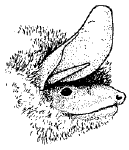 Natterer's
bats start to arrive at their hibernation sites in December with peak
numbers in January or early February. Most leave by early March. They
show a preference for the cool entrance areas of caves and mines, but
will hibernate in any underground shelter.
Natterer's
bats start to arrive at their hibernation sites in December with peak
numbers in January or early February. Most leave by early March. They
show a preference for the cool entrance areas of caves and mines, but
will hibernate in any underground shelter.
Natterer's bats are one of the species most frequently found in any small
cave-like site or even exposed rock crevices. They are usually solitary
but small groups are not uncommon and may include other species. An exceptional
cluster of about 150 bats is regularly found at one site. In their efforts
to lodge in small crevices they can be found in almost any position, including
lying on their back or sides, or even resting on their heads. Individual
Natterer's bats are occasionally found hibernating in churches, in crevices
between beams.
| Description |
|
| Head and Body Length |
40 - 50 mm |
| Forearm Length |
36 - 43 mm |
| Wingspan |
245 - 300 mm |
| Weight |
7 - 12 g |
| Colour |
Fur light buff brown on back, white underneath. Bare
pink face. |
|
|
| |
|
| Life Cycle |
|
| Mating Period |
Autumn and winter. |
| Maternity Colonies |
Late spring.
Young: 1 (occasionally twins) born end of June to early July, weaned
at 6 weeks. |
| Colony Size |
20 - 1,000 plus |
| Longevity |
Up to 20 years |
| UK Status |
Vulnerable. |
|
|
| |
|
| Habitat and Food |
|
| Summer Roosts |
Old stone buildings and large-timbered barns, tree holes. |
| Winter Roosts |
Caves, mines, most underground sites. |
| Feeding Habitat |
Open woodland, parkland, hedgerows, along waterside
vegetation. |
| Food |
Flies, moths, spiders, other small insects.

|
further reading
"Natterer's bats prefer foraging in broad-leaved woodlands and river
corridors" Journal of Zoology Volume 275 Issue 3, Pages 314 - 322
(May 2008).